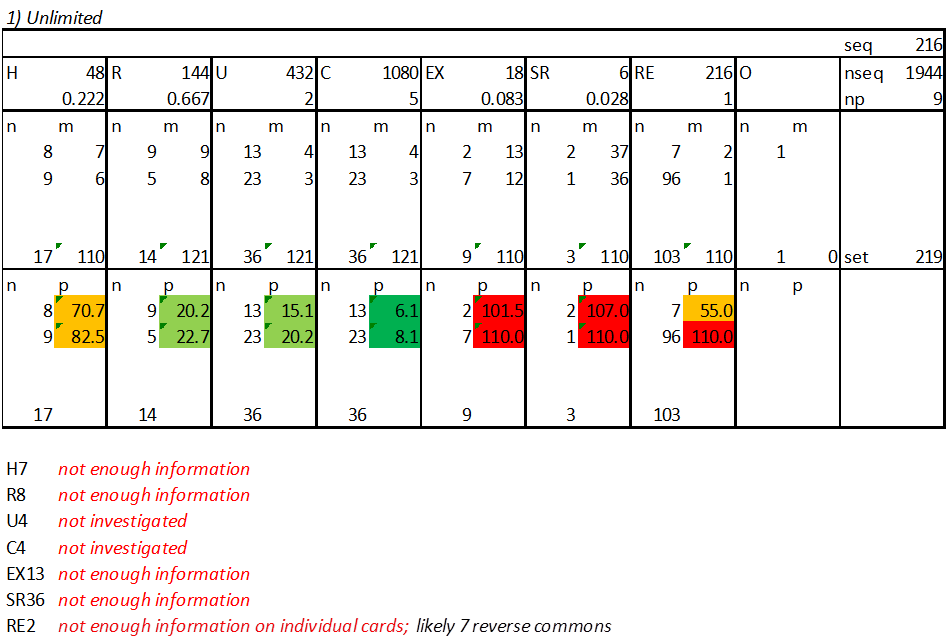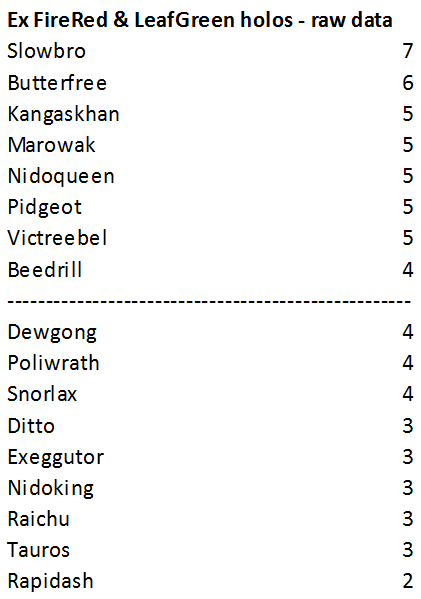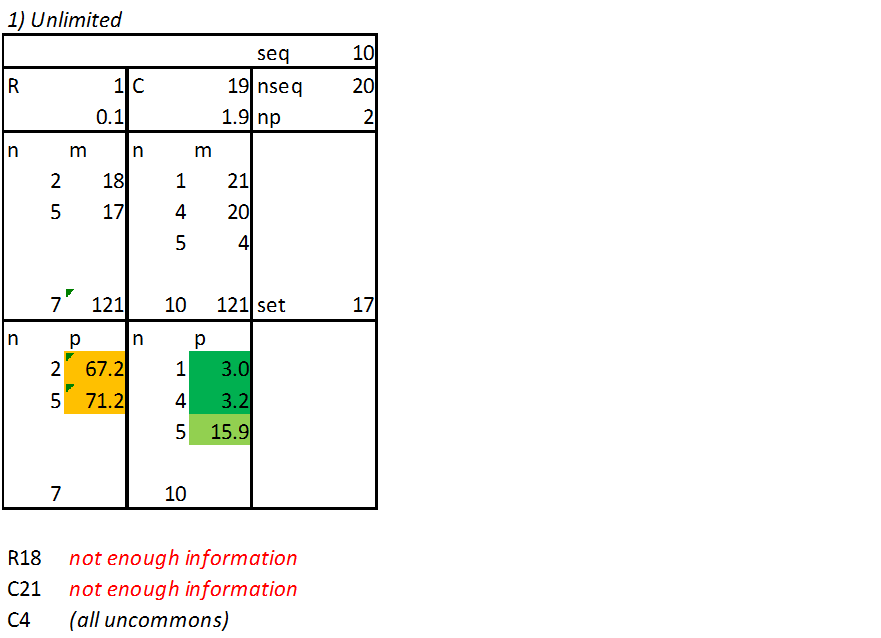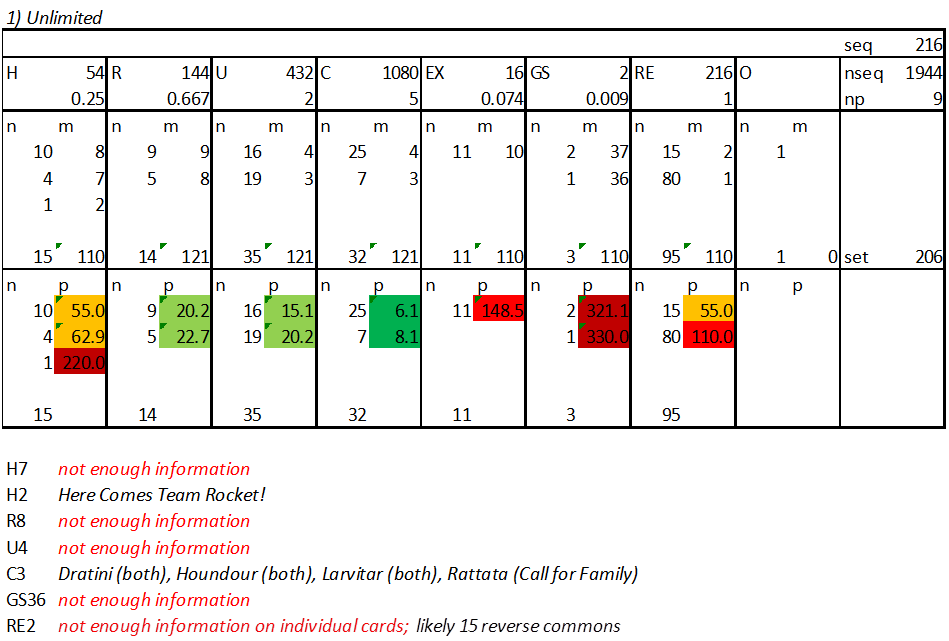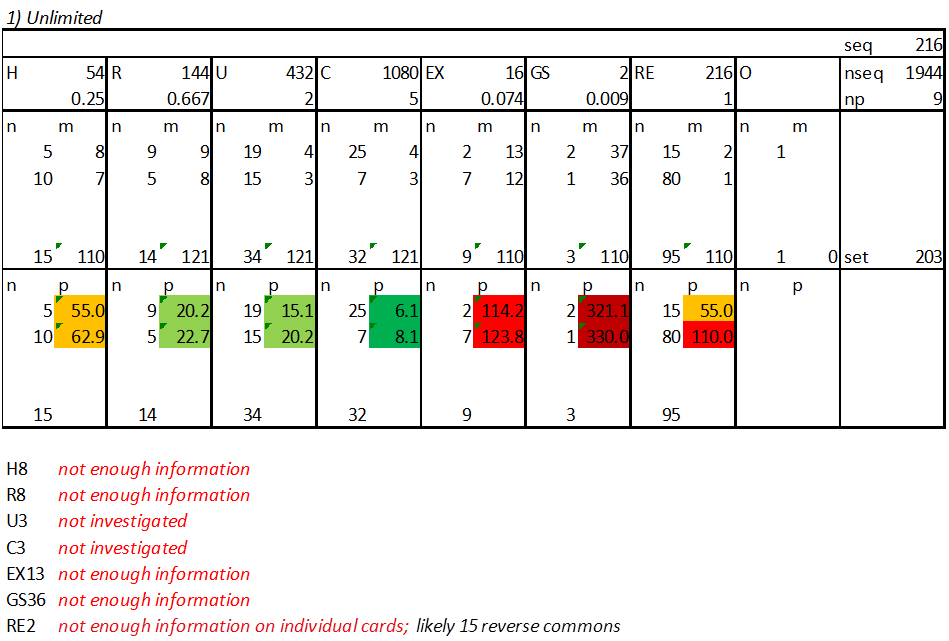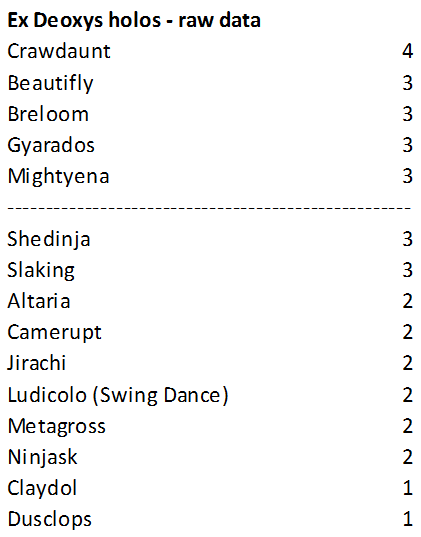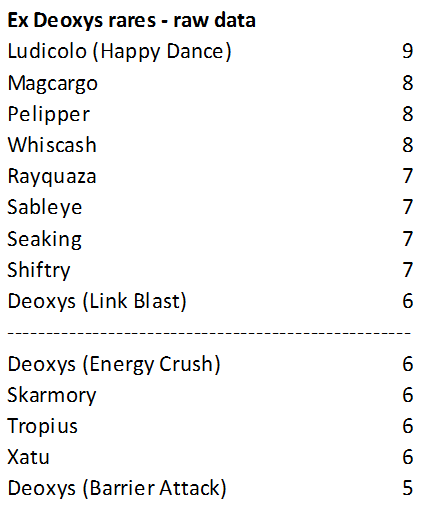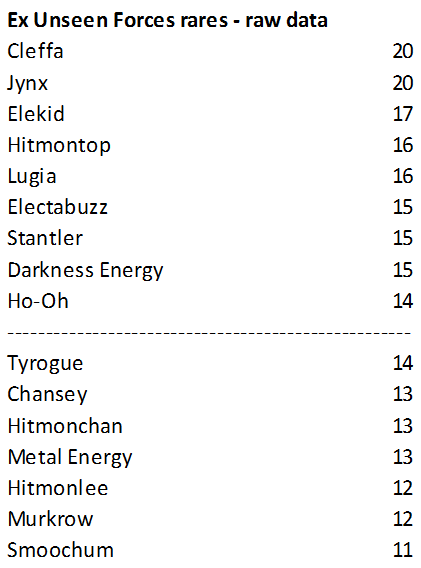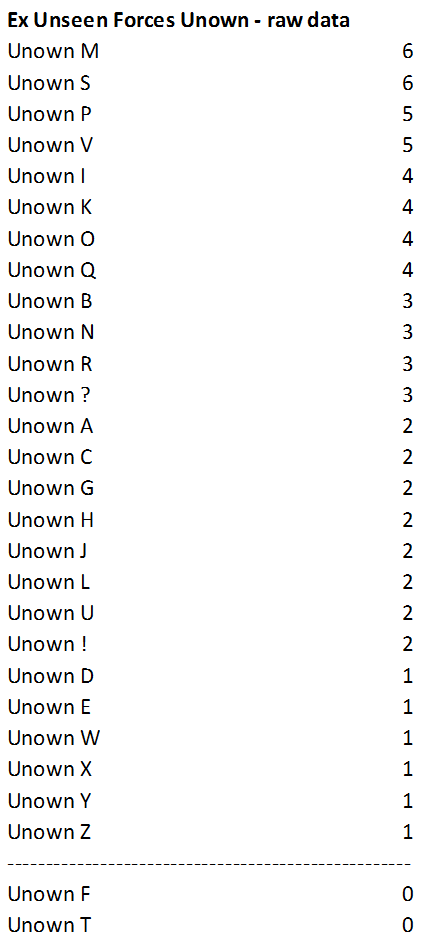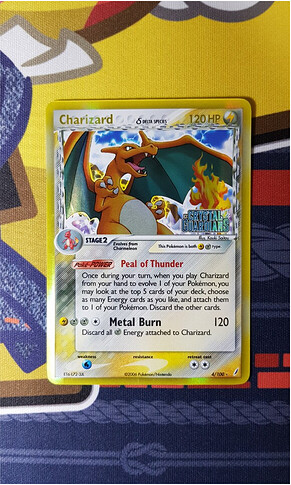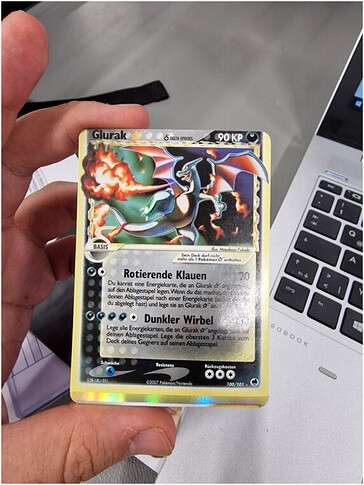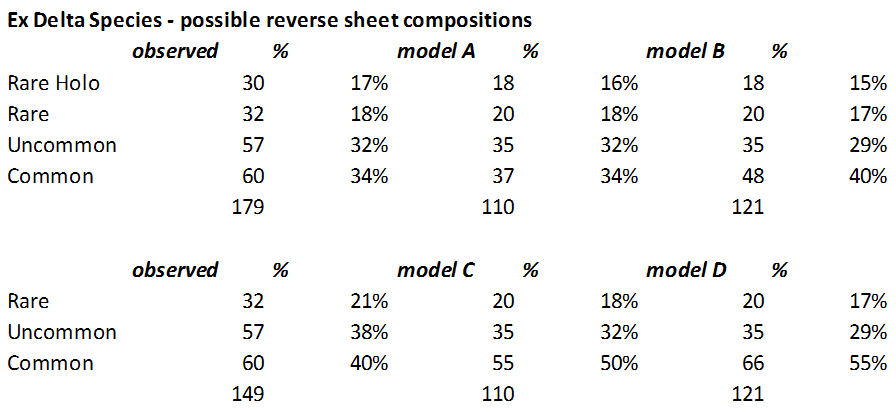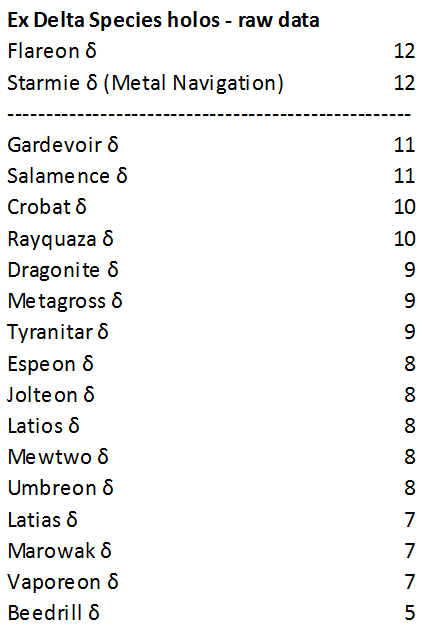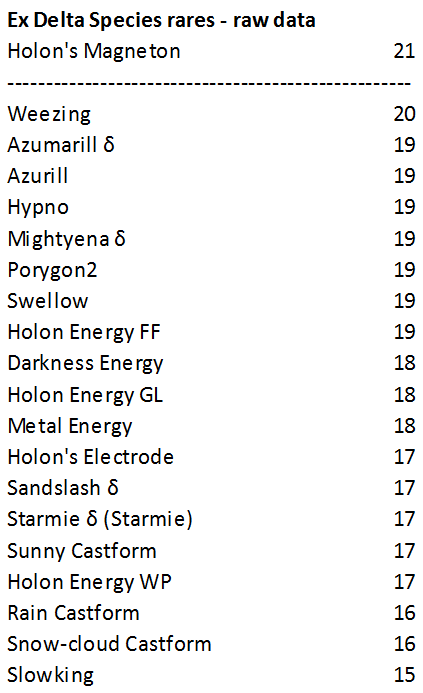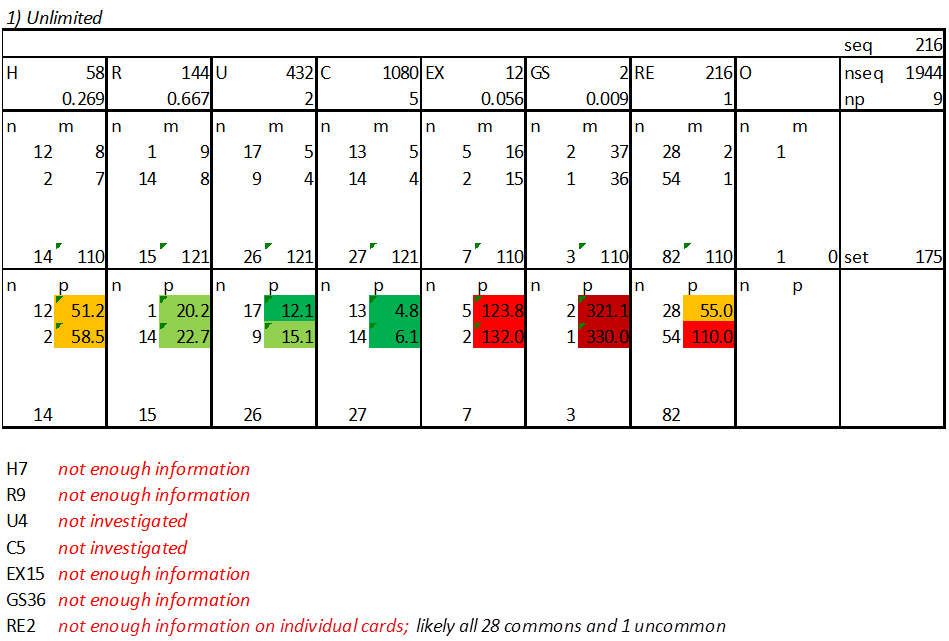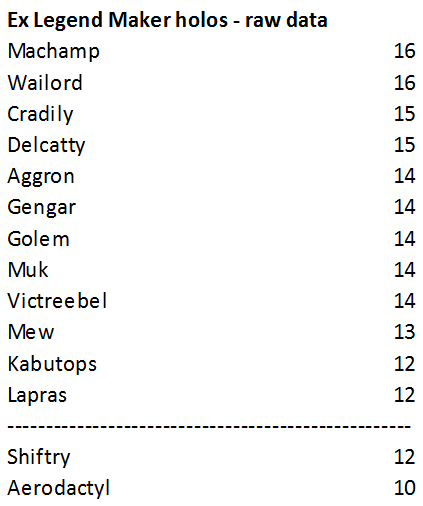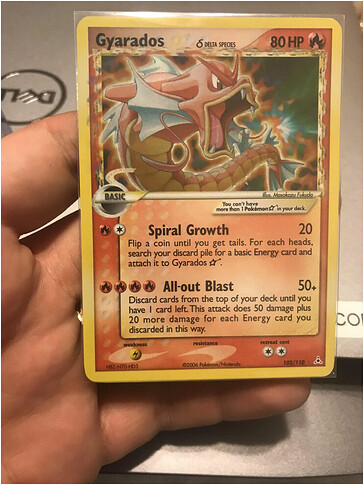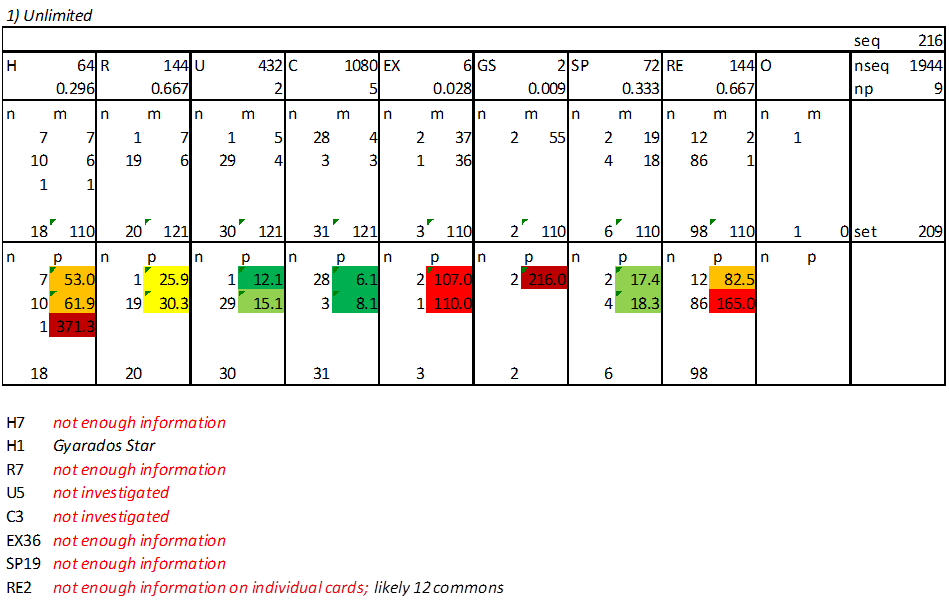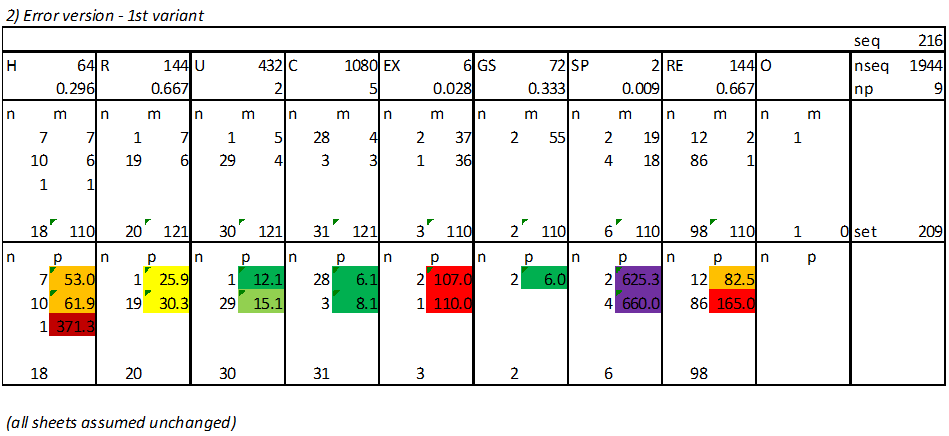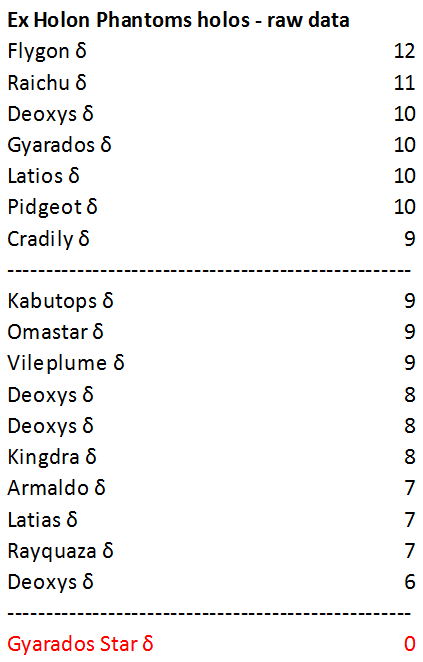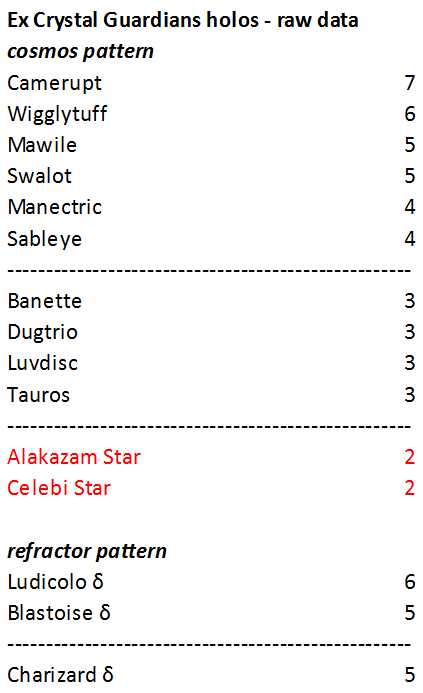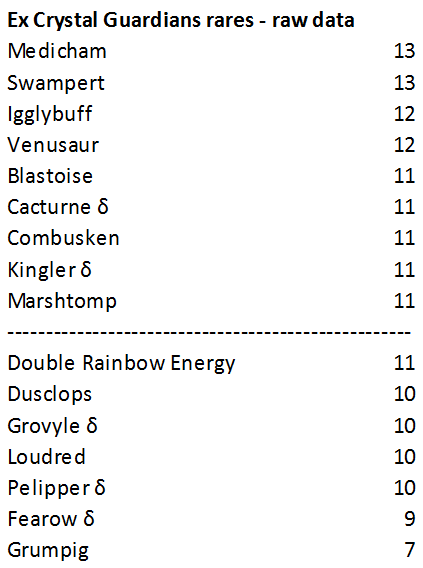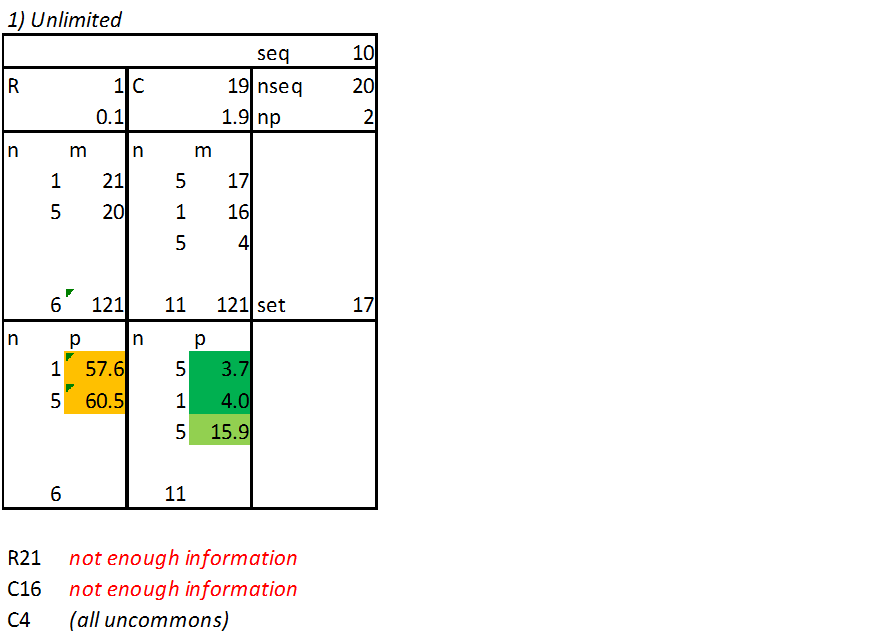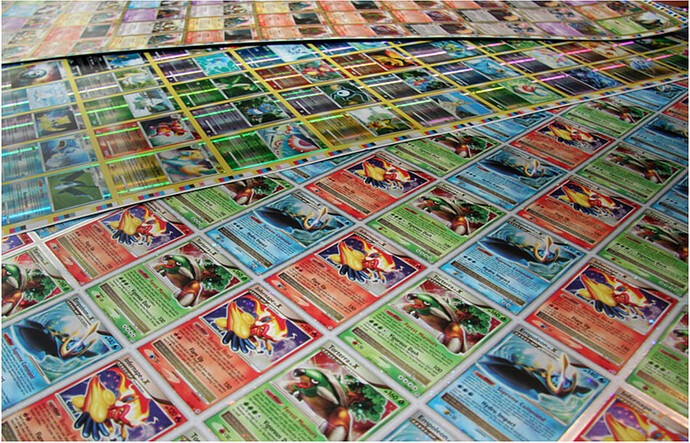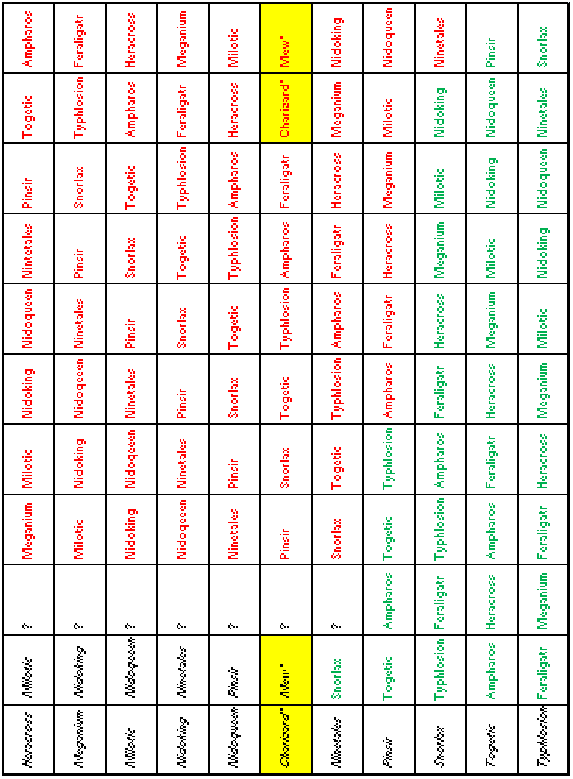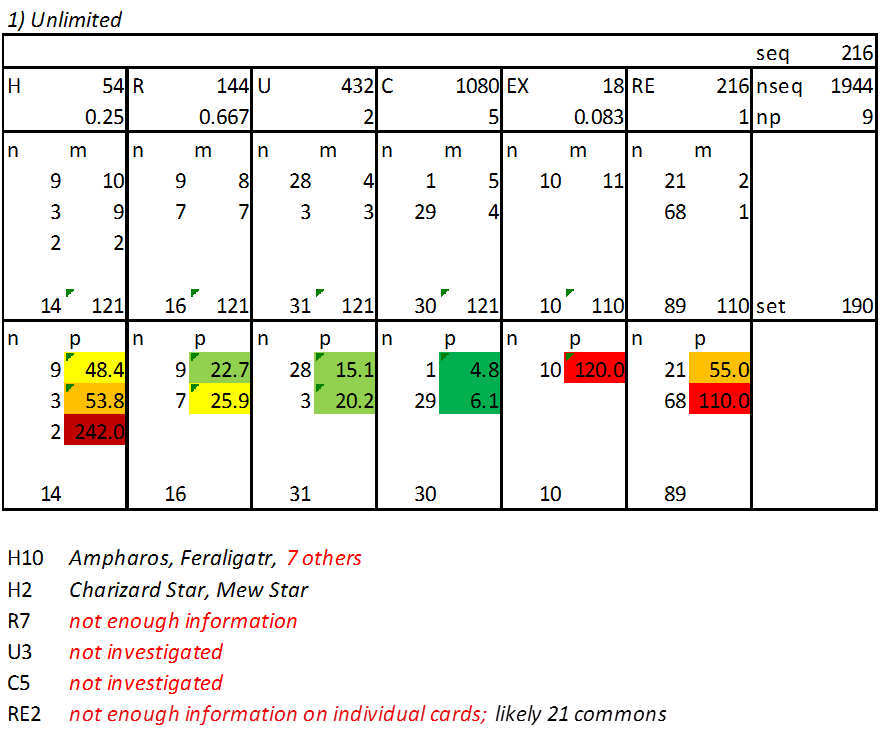I have seen the video, but had never really noticed this segment. I guess you mean the fact that the first two “cartridges” appear to contain the same cards?
I don’t know what the reason is. If they are commons or uncommons, they may be inserted into packs alternatingly (some of the boxes I looked at when reconstructing sheets didn’t look like all the packs in one box made up one sequence), or one “cartridge” might only start inserting cards when the other is empty. As to the reason, it may simply be that using multiple “cartridges” means they don’t have to be refilled as often with cards. But thanks for pointing this out!
Update notice: I have completely updated the data for Base Set, taking into account the fact that different sheets were used for the 1st Edition and Shadowless commons, uncommons, Basic Energies and likely also the rares.
Ex FireRed & LeafGreen
For Ex FireRed & LeafGreen, the number of Pokémon-ex per box increases from 3 to 4, of which one is a secret rare (one of the three legendary birds cards with a cracked-ice holofoil pattern), and the number of holos is reduced to 8. This is due to the fact that the set includes more Pokémon-ex than earlier sets - 12 in total including secret rares. The rarity table looks as follows:
“O” denotes the box topper, Charmander.
The raw data for the holos, rares, Pokémon-ex and secret rares is as follows, the dashed lines indicating where the transitions from H7 to H6, R9 to R8, EX13 to EX12 and SR37 to SR36 would occur:
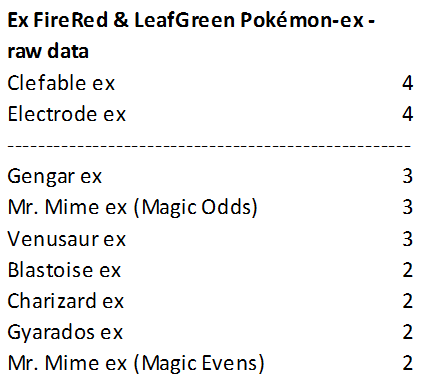
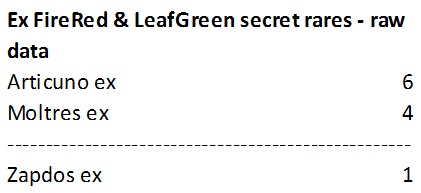
No definite conclusion can be drawn from the data.
I did not look at the commons and uncommons.
As to the reverses, the data alligns pretty well with a 10x10 sheet being used, with 7 reverse commons being printed on the sheet twice:
Edit 23/04/22: typo in rarity table fixed (RE2 cards are likey reverse commons, not reverse uncommons)
POP Series 1
Before we get to the next main set, Ex Team Rocket Returns, and to the big question of how rare the Gold Stars actually are, I decided to give a quick look at POP Series 1, since this is the point these packs were released chronologically, and since all the POP Series packs were later available in various retail products.
As sources, I looked at a few Youtube videos of POP Series 1 and POP Series 2 packs being opened (assuming they can’t be weighed, the bundles of lose packs should be ok as a sample) and compared them with the documented uncut sheet from POP Series 6 shown on Uncut Sheets (it is mislabeled as POP Series 9).
The first two POP series apparently use two sheets, one for the commons and uncommons, and one for the rares (including Pokémon-ex), since if you get a rare it is always the second card. The ratio of commons to uncommons of 101:20 from POP Series 6 also fits the sample data for POP Series 1 and 2 very well. Rares seem to be about 1 in every 10 packs. I don’t have any reason to believe that the two Pokémon-ex (Armaldo and Tyranitar) are any rarer than the other five rares. I also don’t think there are any artificial rarity differences between individual commons and uncommons, though the sample from Youtube yielded a remarkably large number of uncommon Pupitar.
Finally, so far I have used a sequence length of 216 packs (1 case) in my tables. For the POP Series, I will use 10 packs instead, since that is what I would estimate the insertion rate for rares to be. This yields the following table:
The rares (including Pokémon-ex) are actually quite hard to pull.
The next post will dive into the topic of Gold Stars and their rarity.
Digression: How rare are the Gold Stars?
So far, almost all the sets covered here have been assumed to have a fixed, integer number of each type of card per box on average, though in reality the contents of boxes sometimes varies. The sole exception was the “error” print run of Neo Destiny, where I assumed 4.5 Shining Pokémon per box on average, though the actual pull rate is very uncertain, as mentioned in that post. For the Ex Series, the number of Pokémon-ex per box in the various sets was either 6, 3 or 4, including the cracked-ice holofoil Pokémon-ex from Ex Hidden Legends and Ex FireRed & LeafGreen which were 1 per box. Some sets (Team Rocket, Neo Revelation, Aquapolis, Skyridge, Ex Dragon and Ex Team Magma vs Team Aqua) had secret rares that didn’t have a specific number of them per box, but that was because they were most likely printed on the same sheet as the regular holos.
Beginning with Ex Team Rocket Returns, the first set to include Gold Stars, we need to look at types of cards with non-integer average pull rates per box, specifically pull rates smaller than 1 per box. At least for the earlier sets, Gold Stars can’t have been printed on the same sheet as the regular holos, for the following reasons:
- If you look at box openings, the boxes without Gold Stars contain a fixed number of holos and Pokémon-ex. In boxes with a Gold Star, it either takes the place of a holo or that of a Pokémon-ex. For Ex Team Rocket Returns and Ex Unseen Forces, the Gold Star takes the place of a Pokémon-ex. That means Gold Stars can’t have been printed on the holo sheet, and the different card border means they can’t have been printed on the same sheet as the Pokémon-ex either. (In addition, the fact that a large number of Gold Stars from Ex Unseen Forces were stolen from a printing facility also points to them being printed on a separate sheet.)
- Nothing certain can be said about Ex Deoxys, as I didn’t find any video of someone opening up a complete box and pulling a Gold Star.
- In Ex Delta Species, Gold Stars take the place of a holo, but the holos in this set are all delta species Pokémon which have a different holofoil pattern, so in this set as well, there must have been a separate printing sheet for the Gold Stars.
- In Ex Legend Maker, Gold Stars also take the place of a holo. Since the holos have the same holofoil pattern as the Gold Stars, this is the first set for which the Gold Stars may have been printed on the same sheet as the holos. This set and subsequent ones will be looked at in due time.
This means we need to look at large amounts of data in order to be able to say anything about card rarities with any kind of certainty.
Unfortunately, there aren’t that many videos on Youtube of complete Ex Series booster boxes being opened. The sample is too small to draw any conclusions for any individual set. However, I did manage to find 104 videos of box opening of the 9 sets that included Gold Stars (all of them English, since I can’t rule out the pull rates for different language editions being different). That is enough to get at least a general idea of how rare the Gold Stars are, though of course there may be differences between individual sets. (The PokeGym Forums are a good place to see the contemporary discussion about card rarities for the various sets, and I plan to use them as a source when I go through the individual sets.)
The conventional wisdom is that the Gold Stars were included in 1 in every 2 or 1 in every 3 boxes. The data from Youtube looks as follows:
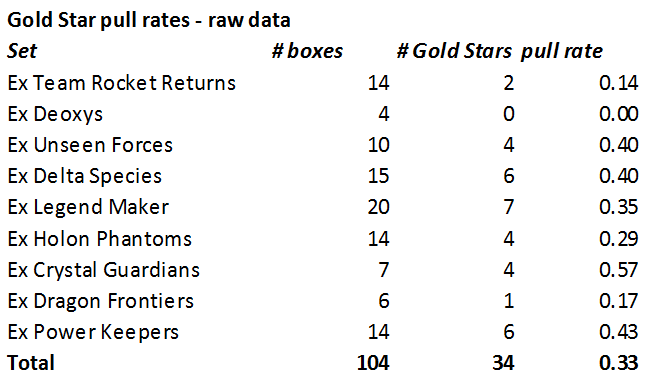
The observed pull rate over all sets was 1 in 3 boxes. I think the sample is large enough to say that at least in general, that is how rare the Gold Stars are, and not 1 in 2 boxes as many sources say. So this is the value I will be using in general, with possible variations depending on the sets.
As to the individual sets, I would like to note the following things:
- The low observed pull rate for the first two sets is remarkable, but in my opinion not quite statistically relevant.
- Those sets with larger samples show a pull rate relatively close to 1 in 3 boxes. The outliers are Ex Crystal Guardians and Ex Dragon Frontiers, both with small sample sizes. I don’t consider theses outliers statistically relevant.
- I only observed one single box containing more than 1 Gold Star, and that was an Ex Power Keepers box containing 4 (which means 11 of the other 13 boxes of this set contained none).
Ex Team Rocket Returns
This set contains the first three English Gold Star cards (Treecko, Torchic and Mudkip). It also contains a secret rare (Here Comes Team Rocket!). The sample size of Youtube videos is larger than for the last few sets, 14 boxes in total. It yielded two Gold Stars (both of them Mudkip) and one single copy of Here Comes Team Rocket!.
What to make out of this? As discussed in the last post, the sample size is large enough for the low number of Gold Star pulls observed to be remarkable, but probably not enough for it to be statistically relevant. Thus I am assuming the Gold Stars have an overall pull rate of 1:108 packs. Looking at the contemporary discussion (How Rare is Too Rare?? | The PokeGym), this seams about right.
As to how rare the secret rare is, this is a very tricky question as the sample is too small to tell with any certainty. It was likely printed on the same sheet as the holos, and since there are 9 holos per box (36 packs), it could be a H2 card with a pull rate of 1:220, or a H1 card with a pull rate of 1:440. While the latter value is closer to what the sample yielded, I will go for the prior, just to be cautious. I would rather err in modelling the differences in rarity between cards printed on the same sheet too small than too large.
This leads to the following rarity table (“O” denoting the box topper, Charmeleon):
Even without assuming a pull rate of 1:440 for the secret rare, the Gold Stars set a new record for “rarest card so far”, about twice as rare as any non-reverse seen up to this point.
The raw data for the holos and rares is shown below (dashed lines showing the transitions from H8 to H7, H7 to H2 and R9 to R8). If Here Comes Team Rocket! were assumed to be a H1 card, there would be one more H8 card and one fewer H7. There is no need to show raw data for the Pokémon-ex, as they all fit on one sheet an equal number of times.
While no definitive conclusions can be drawn, I wouldn’t be surprised if Dark Dragonite and the Dark Tyranitar with Sand Damage as its Ability, the two cards included as holo variants in the theme decks, were both R8.
I did look at the commons and uncommons for this set. I can’t be sure about the uncommons yet, but the reconstructed commons sheet looks as follows:
† Swinub, Houndour (Rear Kick), Wooper, Houndour (Dark Lift), Spinarak, Psyduck, Larvitar (Fury Attack), Zubat, Cubone, Magnemite, Sandshrew, Hoppip, Koffing, Magikarp, Rattata (Call for Family), Dratini (Dragon Song), Slowpoke, Mareep, Remoraid, Grimer, Rattata (Scramble), Marill, Drowzee, Sentret, Horsea, Voltorb, Ekans, Slugma, Onix, Sandshrew, Hoppip, Wooper, Psyduck, Grimer, Spinarak, Koffing, Dratini (Pound), Remoraid, Larvitar (Light Punch), Zubat, Cubone, Swinub, Larvitar (Fury Attack), Ekans, Slowpoke, Houndour (Rear Kick), Magikarp, Marill, Drowzee, Sentret, Ledyba, Rattata (Scramble), Horsea, Magnemite, Dratini (Dragon Song), Onix, Mareep, Voltorb, Slugma, Houndour (Dark Lift), Wooper, Marill, Sandshrew, Psyduck, Cubone, Zubat, Onix, Larvitar (Light Punch), Hoppip, Spinarak, Larvitar (Fury Attack), Rattata (Scramble), Dratini (Pound), Sentret, Koffing, Magnemite, Grimer, Remoraid, Ledyba, Magikarp, Swinub, Ekans, Rattata (Call for Family), Mareep, Slugma, Horsea, Voltorb, Slowpoke, Drowzee, Houndour (Rear Kick), Cubone, Houndour (Dark Lift), Rattata (Call for Family), Grimer, Mareep, Swinub, Koffing, Dratini (Dragon Song), Psyduck, Sandshrew, Larvitar (Light Punch), Sentret, Hoppip, Voltorb, Ledyba, Rattata (Scramble), Dratini (Pound), Wooper, Magnemite, Spinarak, Drowzee, Slowpoke, Magikarp, Slugma, Marill, Ekans, Zubat, Onix, Horsea, Remoraid, Ledyba †
As with previous sets, Pokémon with two versions tend to be the ones selected to appear fewer times on the sheet.
The reverses were likely printed on a 110 card sheet, as a model with 15 reverse commons printed on the sheet twice fits the data much better than a model using a 121 card sheet:
Ex Deoxys
Despite the fact that this set contains the famous Gold Star Rayquaza card, there is not terribly much to say about it, save for the fact that compared with Ex Team Rocket Returns, another set considered very hard to find nowadays, there are very few (four in total) videos of complete box openings on Youtube.
All four boxes contained 9 holos, 3 Pokémon-ex and 0 Gold Stars. I will assume the Gold Stars take the place of a Pokémon-ex when they appear, as is the case in Ex Team Rocket Returns and Ex Unseen Forces. I am also guessing their overall rarity to be 1 in 3 boxes, like the average of all the sets containing them.
The rarity table for this set looks like the one for Ex Team Rocket Returns, minus the secret rare (“O” being the box topper, Rocket’s Raikou ex):
The raw data for the holos, rares and Pokémon-ex looks as follows (dashed lines indicating where the transition from H8 to H7, R9 to R8 and EX13 to EX12 would occur):

I did not look at the commons or uncommons. The reverses data (3 of the 4 boxes looked at) best fits a 110 card sheet being used, with 15 reverse commons being printed twice:
Why would the fixed number of holos and ex suggest that they are not on the same sheet?
I get there are other points like holofoil pattern that is a stronger indicator but not sure why the former is relevant?
Because if you look for example at Ex Team Rocket Returns, you get either 9 holos and 3 Pokémon-ex or 9 holos, 2 Pokémon-ex and 1 Gold Star in a box. If holos and Gold Stars were printed on the same sheet, I see no way to ensure the Gold Stars all land in boxes with 10 cards from that sheet and only 2 Pokémon-ex. You would end up with boxes with 10 holos and 2 Pokémon-ex, and such with 8 holos, 1 Gold Star and 3 Pokémon-ex.
For some later sets like Ex Legend Maker, you get either 10 holos and 2 Pokémon-ex, or 9 holos, 2 Pokémon-ex and a Gold Star. Here, it would be possible that the Gold Stars were printed on the same sheet as the holos.
I hope this answer is helpful.
Ex Emerald
Ex Emerald contains no Gold Stars, but it is the first set to contain some kind of special cards (abbreviated “SP” in my rarity table) in the reverse slot. These are the six holographic Basic Energy cards. They appear in 1 in 3 packs, with all but one of the seven boxes opened on Youtube containing exactly 12 of them, and since their holofoil pattern is totaly different from that of the reverses, they must have been printed on a separate sheet. Aside from that, each box contains on average 9 holos and 3 Pokémon-ex, leading to the following rarity table (“O” is the box topper, Farfetch’d):
Since there are 11 holos and 11 Pokémon-ex, they likely all have the same pull rate; the sample showed nothing to the contrary, either. For the rares, the raw data looks as follows (dashed line indicating wheree the transition from R9 to R8 would occur:
Three of the (not so desirable) four rare Energy cards appeared the fewest times, which is probably no coincidence. The Darkness Energy may very well be a R8 card as well, despite being one of the cards showing up the most times; the sample is too small to rule it out.
For the holographic Energy cards, Water and Psychic Energies appeared the most often, but the sample is far too small to say which two are the SP19 Energy cards.
I looked at the reverses for 4 of the 7 boxes and it looks like they were still printed on a 110 card sheet, with 21 commons appearing on the sheet twice. The table below compares the sample data to models using a 110 and a 121 card sheet:
One note of interest: Since the Pokémon-ex appeared in 1 in 12 packs, and the holo Energy cards in 1 in 3, I wondered if there was any regularity as to whether packs could contain a Pokémon-ex and a holo Energy card. The result was interesting: In three of the four boxes, all packs containing Pokémon-ex also contained a holo Energy card; in the fourth one, none did. Since not all the boxes are the same, I would consider this more of a coincidental effect from the way the cards were printed than anything intentionally planned this way.
I reconstructed the commons sheet, which shows the 7 C3 cards to all be Pokémon of which there are two common versions in the set. I looked as follows:
† Baltoy, Makuhita, Electrike (Rear Kick), Larvitar, Doduo, Ralts, Gulpin, Spoink (Knock Away), Spoink (Lunge), Whismur, Pikachu, Feebas (Water Arrow), Electrike (Double Kick), Luvdisc, Mudkip, Meditite, Duskull, Pichu, Taillow, Torchic, Zigzagoon, Swablu, Snorunt, Cacnea, Shroomish, Whismur, Rhyhorn, Numel (Collect), Treecko, Vulpix, Baltoy, Larvitar, Makuhita, Ralts, Doduo, Gulpin, Electrike (Double Kick), Luvdisc, Torchic, Pichu, Spoink (Lunge), Taillow, Mudkip, Pikachu, Numel (Stampede), Duskull, Meditite, Electrike (Rear Kick), Numel (Collect), Snorunt, Spoink (Knock Away), Voltorb, Vulpix, Zigzagoon, Treecko, Feebas (Water Arrow), Shroomish, Swablu, Cacnea, Rhyhorn, Feebas (Submerge), Pikachu, Torchic, Taillow, Larvitar, Makuhita, Gulpin, Ralts, Voltorb, Doduo, Luvdisc, Pichu, Mudkip, Baltoy, Spoink (Lunge), Whismur, Vulpix, Electrike (Rear Kick), Meditite, Duskull, Snorunt, Zigzagoon, Voltorb, Treecko, Swablu, Shroomish, Cacnea, Spoink (Knock Away), Rhyhorn, Numel (Stampede), Electrike (Double Kick), Feebas (Water Arrow), Feebas (Submerge), Larvitar, Baltoy, Makuhita, Ralts, Torchic, Taillow, Doduo, Gulpin, Luvdisc, Pichu, Meditite, Mudkip, Pikachu, Spoink (Lunge), Duskull, Zigzagoon, Numel (Collect), Vulpix, Snorunt, Shroomish, Cacnea, Treecko, Whismur, Voltorb, Numel (Stampede), Rhyhorn, Swablu, Feebas (Submerge) †
Edit 2023/05/16: Corrected a mistake in the rarity table and text: The holofoil Energy Cards are 1 in 3 packs, not 1 in 4. I also added the reconstructed commons sheet.
Ex Unseen Forces
Ex Unseen Forces has it all: Gold Stars, a secret rare and “special” cards - in this case, the Unown - inserted in the reverse slot. That makes putting together the rarity table rather complicated, and these three types of cards need to be looked at first before doing so:
The simplest question is that of Celebi ex, the secret rare. The sample from Youtube (10 boxes) is too small to say anything definitive about the rarity. But given the fact that the set includes 13 Pokémon-ex that can be pulled from booster packs (including Celebi ex), all of them are already quite rare, so personally I doubt Celebi ex was artificially made even rarer by printing it fewer times on the sheet than the other Pokémon ex. 13 Pokémon ex would mean 6 with EX9 and 7 with EX8 rarity, and I am going to assign Celebi ex EX8, or 1 in 185.6 packs, as its “best guess” rarity.
Next, the Gold Stars. I wrote in my introductory post on the Gold Stars that they seem to take the place of a Pokémon-ex in this set, just like in Ex Team Rocket Returns. The individual boxes on Youtube looked as follows:
- 3 had 9 holos and 3 Pokémon-ex
- 3 had 9 holos, 2 Pokémon-ex and 1 Gold Star
- 1 had 8 holos, 3 Pokémon-ex and 1 Gold Star
- 1 had 10 holos and 3 Pokémon-ex
- 1 had 11 holos and 3 Pokémon-ex
- 1 had 11 holos and 2 Pokémon-ex
For this reason, and also because of the fact a number of Gold Stars from this set were apparently stolen from a printing facility, I am assuming the average box has 9 holos, 2 2/3 Pokémon-ex and 1/3 Gold Stars, though (as with most other sets) “error” boxes are quite common.
Finally, the Unown. Since the reverses in this set have a special holofoil pattern featuring Poké Balls and the Unown don’t, they must have been printed on a separate sheet. Their rarity is about 1 in 5 packs (the Youtube data yielded 72 Unown in 360 packs, exactly 1 in 5), but this poses a problem with the sequence length of 216 packs I am going with. As mentioned in the very first post in this thread, I chose this length (which signifies the number of packs after which the pattern with which certains types of cards are inserted into packs starts to repeat) so I could fit all the observed rarities for Generation 1 to Generation 5 sets into the sequence. Gold Stars seem to be about 1 in 3 boxes, the Ace Spec cards from Plasma Storm and Plasma Blast are about 1.5 per box or 3 in 2 boxes, the Alph Lithograph cards from Unleashed, Undaunted and Triumphant are about 1 in 6 boxes on average. Using a sequence length of 216 packs (which also corresponds to 1 case of 6 boxes) for all sets fits very well, though of course the sequence length may easily vary between sets. 216 however is not divisible by 5, so there are different solutions to model the rarities in this set:
- change the sequence length from 216 to 540, with 5 Gold Stars and 108 Unown. Gold Stars are 1 in 108 packs (3 boxes) and Unown are 1 in 5 packs.
- keep the sequence length at 216, with 2 Gold Stars and 43 Unown. Gold Stars are 1 in 108 packs and Unown are 1 in 5.02 packs, the closest to 1 in 5 you can get with this sequence length.
- keep the sequence length at 216, with 2 Gold Stars and 42 Unown. Gold Stars are 1 in 108 packs and Unown are 1 in 5.14 packs, which is exactly 7 per box on average.
I chose to go with the second option, though any of the three is perfectly possible.
The rarity table looks as follows (“O” denoting the box topper, Rocket’s Persian ex):
As can be seen, the set contains quite a lot of very rare cards: Gold Stars, Pokémon-ex, the Unown and also the reverses. It is also the first set since Skyridge where all the rares are rarer than all the uncommons.
The raw data for the holos, rares, Pokémon-ex and Unown is as follows (dashed lines indicating where the transition from H6 to H5, R8 to R7, EX9 to EX8 and SP4 to SP3 would occur:

The sample is too small to say anything certain about individual card rarities.
I did not look at the uncommons, but was able to reconstruct the commons sheet. It looks as follows:
† Gloom, Poliwag, Teddiursa, Pineco, Gligar, Totodile, Oddish, Houndour, Flaaffy, Natu, Snubbull, Remoraid, Chikorita, Potion, Mareep, Slugma, Poliwag, Sunkern, Clefairy, Slowpoke, Gligar, Chinchou, Onix, Snubbull, Chikorita, Poliwhirl, Flaaffy, Pineco, Hoothoot, Houndour, Pupitar, Eevee, Oddish, Slugma, Chinchou, Remoraid, Gligar, Hoothoot, Porygon, Totodile, Pineco, Energy Search, Mareep, Spinarak, Gligar, Poliwhirl, Sunkern, Slugma, Natu, Wooper, Flaaffy, Potion, Slowpoke, Remoraid, Pineco, Larvitar, Onix, Teddiursa, Totodile, Oddish, Clefairy, Pupitar, Poliwag, Energy Search, Snubbull, Teddiursa, Spinarak, Mareep, Larvitar, Cyndaquil, Gloom, Chinchou, Houndour, Potion, Natu, Porygon, Eevee, Onix, Poliwag, Flaaffy, Oddish, Totodile, Wooper, Porygon, Chikorita, Slugma, Larvitar, Eevee, Cyndaquil, Sunkern, Hoothoot, Pupitar, Wooper, Gloom, Natu, Clefairy, Remoraid, Eevee, Wooper, Poliwhirl, Teddiursa, Cyndaquil, Porygon, Onix, Houndour, Slowpoke, Sunkern, Clefairy, Chikorita, Cyndaquil, Mareep, Spinarak, Hoothoot, Snubbull, Poliwhirl, Chinchou, Energy Search, Larvitar, Spinarak, Pupitar, Slowpoke †
As to the reverses, as usual I compared raw data with models using a 110 card and a 121 card sheet and filling out the “extra” spaces with commons, and the 110 card sheet continues to fit the raw data better:
An that concludes what I can say about this set.
POP Series 2
Bulbapedia gives the release date of Ex Unseen Forces as August 22, 2005, and that of POP Series 2 as August 2005. So whichever of the two actually came out first, it’s time to look at POP Series 2 now.
Since just like POP Series 1 it contains 5 commons, 5 uncommons and 7 rares (including Pokémon-ex), and since the videos I found on Youtube make it appear like the rarities are the same as well (uncommons to commons about 20:101, and a rare in every 10th pack which always appears as the second card in the pack), I can simply copy the rarity table for POP Series 1 and paste it here:
Ex Delta Species
Don’t get fooled by the card scans in this post - it is actually about Ex Delta Species.
This is the first set to feature Delta Species Pokémon. All the holos in the set are Delta Species. They use a new holofoil pattern compared to earlier sets, the “refractor” pattern similar (or possibly the same) to that used for the reverses in early Ex Series sets. The three Pokémon-ex and the three Gold Stars, by contrast, use the regular “cosmos” holofoil pattern. As to the reverses, they use the same “refractor” pattern as the holos, with the reverse rares and reverse rare holos being distinguished by gold HP text, and the reverse rare holos (but not the reverse rares) by a holofoil card border.
A box typically contains either 11 holos and 1 Pokémon-ex or 10 holos, 1 Pokémon-ex and 1 Gold Star. I am assuming the Gold Stars have a rarity of 1 in 3 boxes, as is the average over all the sets featuring them.
This leads to the question, which cards were printed on which sheets? For the non-reverses, the answer is straightforward: different holofoil patterns and the fact that the Gold Stars take the place of a holo (as opposed to earlier sets, where they take the place of a Pokémon-ex) mean three different sheets for holos, Pokémon-ex and Gold Stars must have been used.
For the reverses, the answer is less clear. The holofoil card border would be a potential reason to use a separate sheet to print the reverse rare holos, but at the same time, the colour difference between yellow and holofoil yellow isn’t so striking as to make the cards aesthetically unappealing if they aren’t well centered and a little bit of holofoil holo is visible on a plain yellow card border, or vice versa.
I did not find any images of reverses from this set featuring such a stripe of different colour on the edge (I am grateful if anyone can provide any), but I did find one for a later set which has the same card layout for the reverses:
The Charizard from Ex Crystal Guardians features a sliver of non-holofoil yellow on the top of the card. Another example of holofoil and plain yellow card borders on the same sheet are the Gold Stars (which feature a plain yellow border even if they are Delta Species) from Ex Dragon Frontiers, printed on the same sheet as the holos:
The first image is a German miscut; the second a slightly off-centered English card.
To determine if all the reverses from Ex Delta Species were printed on one sheet or not, I looked at the raw data - the number of reverse rare holos, reverse rares, reverse uncommons and reverse commons from a number of boxes - and compared it with four models:
- model A: all cards printed on one 110 card sheet, extra spaces filled in with commons
- model B: all cards printed on one 121 card sheet, extra spaces filled in with commons
- model C: 110 card sheet featuring only reverse commons/uncommons/rares, extra spaces filled in with commons
- model D: 121 card sheet featuring only reverse commons/uncommons/rares, extra spaces filled in with commons
The data shows model A, with a single 110 card sheet including the reverse rare holos, fits best:
With that said, here is the rarity table (“O” denoting the box topper, Azumarill):
The raw data for the holos, rares and Pokémon-ex (with dashed lines signifying where the transition from H7 to H6, R7 to R6 and EX37 to EX36 would occur) looks as follows:
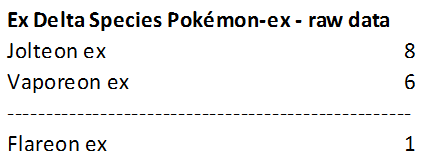
Of the Gold Stars, two each were pulled. I did not look at the commons or uncommons.
Ex Legend Maker
Ex Legend Maker is pretty well documented as far as Youtube videos go, I found no less than 20 videos of complete English box openings. A box typicall contains either 10 holos and 2 Pokémon-ex or 9 holos, 2 Pokémon-ex and 1 Gold Star. There are no Delta Species Pokémon except the box topper, Pikachu δ. (In Japan, this set was released before Ex Delta Species.) This means that this is the first set for which the Gold Stars could have been printed on the same sheet as the holos, since they take the place of a holo and also have the same holofoil pattern and card border.
Whether or not they were is impossible to tell for sure with the available data. In order to assess how such a combined holo/Gold Star sheet may have looked, we need to first determine its size. As mentioned earlier, I am assuming all holofoil sheets switched from 10x11 to 11x11 sheets at the same time, though this is by no means certain.
Looking at some raw data for the reverses, it fits very well with a model in which all 27 commons and 1 of the 26 uncommons were printed twice on a 10x11 sheet:
Now, let’s at how the Gold Stars may have been printed, assuming a 10x11 sheet for all holofoil cards in the set. The average number of observed pulls (for all 20 boxes) was 0.35 per box, or about 1 in 3 boxes. The possible sheet layouts are as follows:
- A separate sheet for the Gold Stars, with two of them printed 37 times and the third printed 36 times on the sheet. The average number of Gold Stars can be fixed at 1 in 3 boxes (0.33 per box), the individual cards have pull rates of 1:321.1 and 1:330.0.
- Each Gold Star is printed once on the holo sheet. With 10 cards from that sheet per box, the average number of Gold Stars is 0.27 per box, the individual cards have pull rates of 1:396.0
- Each Gold Star is printed twice on the holo sheet. The average number of Gold Stars is 0.54 per box, the individual cards have pull rates of 1:198.0.
- Two Gold Stars are printed once on the holo sheet and one is printed twice. The average number of Gold Stars is 0.36 per box, the individual cards have pull rates of 1:198.0 and 1:396.0.
I would rule out the third option as that would make the Gold Stars significantly more common than in other sets, and I think the second one is unlikely at it would make them too rare. The fourth one is plausible but I personally don’t like it - the differences in rarity between the cards are too high for my taste -, so I will be going with the first one (separate sheet for the Gold Stars) in my model.
The rarity table looks as follows (“O” is the box topper, Pikachu δ):
The raw data for the holos, rares and Pokémon-ex is as follows (dashed lines indicating where transition from H8 to H7, R9 to R8 and EX16 to EX15 would occur):

For the Gold Stars, the sample yielded 4 Regice, 3 Registeel and 0 Regirock. I did not look at the commons and uncommons.
POP Series 3
Quite unlike Ex Legend Maker, POP Series 3 is very poorly documented as far as Youtube videos go. Like the previous two POP Series, it contains 5 commons, 5 uncommons and 7 rares (including one Pokémon-ex). The ratio of commons to uncommons appear the same, and rares seem to still appear in about 1 in 10 packs, still obviously printed on a separate sheet as they always appear in the same slot (now the first slot in the pack). So the rarity table is the same as for the first two POP Series:
Ex Holon Phantoms
A box of Ex Holon Phantoms generally contains either 11 holos and 1 Pokémon-ex or 10 holos, 1 Pokémon-ex and 1 Gold Star (all the Gold Star pulls I observed on Youtube were either Mewtwo or Pikachu). It also contains 12 holofoil Energy Cards in the reverse slot, usually 2 of each kind.
I found three threads on the PokeGym Forums covering pull rates in this set:
- HP Box error | The PokeGym
- Holon Phantom number of ex's and *'s per box | The PokeGym
- Weird Holon Phantom's box | The PokeGym
The first and the third thread are about error boxes, of which I didn’t find any evidence of on Youtube: In the latter case, some boxes contained non-holo rares instead of reverses (but they still had the 12 holofoil Energy Cards). The first group of error boxes is insane though: They contained Gold Stars instead of holofoil Energy Cards. Yep, 12-13 Gold Stars per box! It is noteworthy that apparently all the extra Gold Stars were either Mewtwo or Pikachu, and no Gyarados. This makes sense, since the Gyarados Gold Star is a Delta Species Pokémon with a different holofoil pattern from the other two, and must have been printed separately.
The errors also demonstrate that the holofoil Energy Cards were printed on a separate sheet from the reverses (the holofoil pattern looks like it could be the same - I can’t say for sure as I don’t own any English cards from this era - but it would be necessary to use two sheets to print them in any case since 98 different reverses plus the corresponding amount of holofoil Energies - 49 - wouldn’t fit on a single sheet). A look at the raw data from Youtube shows that the reverses were likely printed on a 110 card sheet, with the extra 12 spaces filled out with commons:
Holofoil Energy Cards can come in packs alongside rares, holos and Pokémon-ex (and presumably alongside Gold Stars as well).
As to the rare slot, I am assuming three different sheets, one for Pokémon-ex (all of them Delta Species), one for the two non-Delta Species Gold Stars and one for the holos (also all of them Delta Species) as well as for Gyarados Gold Star. That Gyarados was printed on the same sheet as the holos is obvious from a post on reddit (Reddit - Dive into anything) about a Gyarados with a telltale sliver of yellow holofoil at the bottom of the card. While the picture (see below) doesn’t show it that well as the card is sleeved, the title of the post is very clear: “Gyarados Gold Star: is it miscut/misprint? Look at holo on bottom edge. Value?”
That leaves only the question of what rarity the Gold Stars have, and this is a question I can’t answer with certainty. My guess is cards from the Gold Star sheet (containing Mewtwo and Pikachu) are still 1 in 3 boxes (108 packs), and the Gyarados Gold Star is a H1 card, printed only once on the holo sheet, though I wouldn’t rule out H2 rarity either.
Here are the rarity tables (“SP” denoting the holofoil Energy Cards and “O” the last box topper printed to this date, Mew):
If Gyarados Gold Star is indeed printed only once on the holo sheet, it would be the rarest card so far (discounting the holofoil Energy Cards from the error boxes, which were apparently not omitted completely, but inserted in place of the Gold Stars).
The raw data for the holos, rares and Pokémon-ex is as follows (dashed lines indicating the transition from H7 to H6 etc.):

Of the holofoil Energy Cards, Water and Lightning Energies were the one I observed the most of. I did not look at the commons or uncommons.
Ex Crystal Guardians
This set is one huge mess. From the videos available on Youtube, I gained the impression that the number of Pokémon-ex per box varies considerably more than for other sets; I was not able to tell how many Pokémon-ex there generally are per box, nor whether Gold Stars come in place of holos (like in Ex Delta Species, Ex Legend Maker and Ex Holon Phantoms) or in place of Pokémon-ex (like in earlier sets). Interestingly, this is the same impression players got back in 2006 - see the following two threads on the PokeGym forums:
- CG Ex's and *'s per box | The PokeGym
- How Many Ex Cards Per Booster Box In Crystal Guardians?? | Page 2 | The PokeGym
My Youtube sample of 7 boxes yielded 8.43 holos, 2.43 Pokémon-ex and 0.57 Gold Stars on average per box. An ebay seller who was posting on the PokeGym back then (TheDarkTwins) opened 24 boxes and got 3.04 Pokémon-ex and 0.17 Gold Stars on average per box.
The reason the contents of individual boxes seems to vary a lot is possibly connected to the fact that there were most likely no less than 4 different sheets used to print the holos, Pokémon-ex and Gold Stars, and they may have been inserted into packs in a somewhat irregular sequence:
- 1 cosmos holofoil sheet for the “regular” holos (10 in total) which likely also contained the two Gold Stars (neither of them is a Delta Species Pokémon) (all with yellow borders)
- 1 cosmos holofoil sheet for the “regular” Pokémon-ex (9 in total) (all with silver borders)
- 1 refractor holofoil sheet for the 3 Delta Species holos (Blastoise δ, Charizard δ and Ludicolo δ) (all with holofoil yellow borders)
- 1 refractor holofoil sheet for Sceptile ex δ (with silver borders)
I will hypothetically assign the sheets listed above insertion rates of 42, 12, 16 and 2 per 216 packs, respectively, as this leads to all the holos and all the Pokémon-ex being of similar rarity, whether they are Delta Species Pokémon or not.
Before looking at how many times the Gold Stars were likely printed on the holo sheet, it is necessary to look at the reverses to see if the sheet size is still 10x11 or already 11x11. The data isn’t completely conclusive, but the best fit looks like a 10x11 sheet with 22 reverse commons printed twice, so this is the sheet size I will be assuming for all holofoil sheets:
In my model I am assuming each Gold Star to be printed twice on the holo sheet, making the individual cards less rare than most of the Gold Stars from earlier sets, but at the same time making the overall pull rate for Gold Stars lower than for other sets with 3 Gold Stars in them (1 in 141.4 packs, to be exact). I do not consider the fact that I saw 4 Gold Stars pulled in my small sample of 7 boxes statistically relevant.
The rarity table looks as follows, with Ha being the “regular” holo sheet, Hb the Delta Species holo sheet, EXa the “regular” Pokémon-ex sheet and EXb the Delta Species Pokémon-ex sheet which only includes Sceptile ex δ:
The raw data for the holos, rares and Pokémon-ex is shown below, with the dashed lines indicating where the transition from H11 to H10 etc. would occur. For the Pokémon-ex, I decided to not just include my own Youtube sample, but also that which TheDarkTwins posted on the PokeGym forums:
I did not look at the commons or uncommons.
POP Series 4
POP Series 4 is not fundamentally different from the previous three POP Series. It contains 6 rares (including one Pokémon-ex), 5 uncommons and 6 commons, while the other three had 7 rares, 5 uncommons and 5 commons. The rares are still printed on a separate sheet and seem to still come 1 in every 10th pack, and the ratio of 20 uncommons on a 121 card non-holo sheet still seems about right. The rarity table looks as follows:
Ex Dragon Frontiers
For this set, there is actually an image of the uncut holo sheet on Uncut Sheets. I initially thought it wouldn’t yield any valuable information since only a small part of the sheet is visible. I was wrong. It provides extremely interesting insights into how holo sheets were designed by Nintendo/TPCI at the time.
Let’s first go over what is independently known about sheets and card rarities in this set:
My small Youtube sample of only six boxes yielded 5 containing 9 holos and 3 Pokémon-ex, and 1 containing 8 holos, 3 Pokémon-ex and 1 Gold Star. This is much more consistent than Ex Crystal Guardians, possibly because with all the holos, Pokémon-ex and Gold Stars being Delta Species Pokémon, only 2 sheets are required to print them. Due to the image of the miscut German Charizard Gold Star which I posted in my analysis of Ex Delta Species, the Gold Stars are known to have been printed on the same sheet as the holos. The card below Charizard looks like a Lightning type, which can only be Feraligatr δ. Interestingly, I found an image of a miscut German Mew Gold Star which was printed above a Charizard Gold Star.
For the reverses, I performed the usual analysis to check if a 10x11 or an 11x11 sheet was used. Just like with Ex Crystal Guardians, it’s not absolutely conclusive but it very much looks like a 10x11 sheet was used, with 21 commons appearing on the sheet twice:
But we are close to the point where the switch to a 11x11 (121 card) sheet occurs: I have looked at the reverses for the next two sets, and it appears that for Ex Power Keepers, all 91 reverses were printed once and all six holofoil Energy Cards five times on a 121 card sheet, and for Diamond & Pearl, all 119 reverses were printed on the same sheet, 2 of them appearing twice.
Now to the holo sheet (shown above). The last few cards on the right are visible for the top 10 (of 11) rows. It appears the same sequence of cards is being repeated on each row, and that the sequence follows the set numbering (which is alphabetical). Between the first and the second row, it is shifted two cards to the right; between the following 6 rows it is shifted one card to the right. Then, between rows 8 and 9 it is shifted two cards to the left, then two to the right, and the final row is not visible.
The fact that for most of the rows the sequence is shifted to the right by one card is very revealing: Since the set contains 12 holos, it looks very much line an 11x11 sheet (11 columns) was used! Since the reverses appear to still be using a 10x11 sheet, this disproves my working hypothesis that all the holofoil sheets switched from 10x11 to 11x11 at the same time. But it would not be the first time things aren’t quite as simple as Occam’s Razor would suggest - the unusual 10x11 non-holofoil sheet apparently used to print the commons for Neo Destiny being the best example.
With that, rows 3 to 8 can be assumed to contain the 12 holos printed in set order. As to rows 1, 2, 10 and 11, if the sheet is to begin with Ampharos δ and end with Typhlosion δ, there are a total of 4 free spaces, which can be assumed to contain the Gold Stars, both of which would have H2 rarity. I place the Charizard Gold Star in row 2 above Feraligatr δ due to the miscut (incidentally, this happens to be the middle column of the sheet), and the Mew Gold Star in row 1 right above it. The position of the Gold Stars in rows 10 and 11 is hypothetically in the same column. Finally, in row 9 three cards have likely been left out of the sequence. They are the three H9 cards; it is not known which ones they are, though Ampharos and Feraligatr must both have H10 rarity. The holo sheet would then look as follows (green - known; red - inferred; black cursive - hypothetical):
Since the reverse and holo sheets have different sizes, there is no way to tell what size the Pokémon-ex sheet had. I am hypothetically gowing with 10x11, but that is no more than a guess.
What conclusions can be drawn?
- The transition from 10x11 to 11x11 card sheets happened at least one set apart for holos and reverses. I will assume that the various holofoil sheets used for Ex Crystal Guardians and earlier were all 10x11, but this is not certain. Similarly, starting with Ex Power Keepers I will assume all sheets to be 11x11 unless I find evidence to the contrary.
- The holo sheet is notable in that it prints the card in set order and has no permutations of the sequence - unlike Team Rocket, the last known holo sheet.
The rarity table looks as follows:
The raw data for the holos and rares is shown below (dashed lines indicating where the transition from H10 to H9 etc. would occur); the Pokémon-ex are assumed to all have the same rarity in my model:
I did not look at the commons or uncommons.
Update notice: Fixed an error in the text and rarity table for Ex Emerald: The holofoil Energy Cards are 1 in 3 packs, not 1 in 4. I also used the opportunity to add the reconstructed commons sheet.
